Teagasc has been running a series of breeding events on farms around the country in association with the Irish Cattle Breeding Federation (ICBF) over the last few weeks.
Last week was the turn of Leitrim, with Carrigallen man Niall Patterson as the host for the evening. Niall is no stranger to the Irish Farmers Journal, having been a participant on the Teagasc/Irish Farmers Journal BETTER Farm Beef programme a few years back.
Tom Coll, James Keane and Catherine Egan, Teagasc all spoke on the night along with Niall Kilrane from ICBF.
The Patterson family run a commercial herd of 35 spring/autumn calving cows, predominantly Charolais and Limousin-crossed, along with 100 lambing ewes on their 40ha farm.
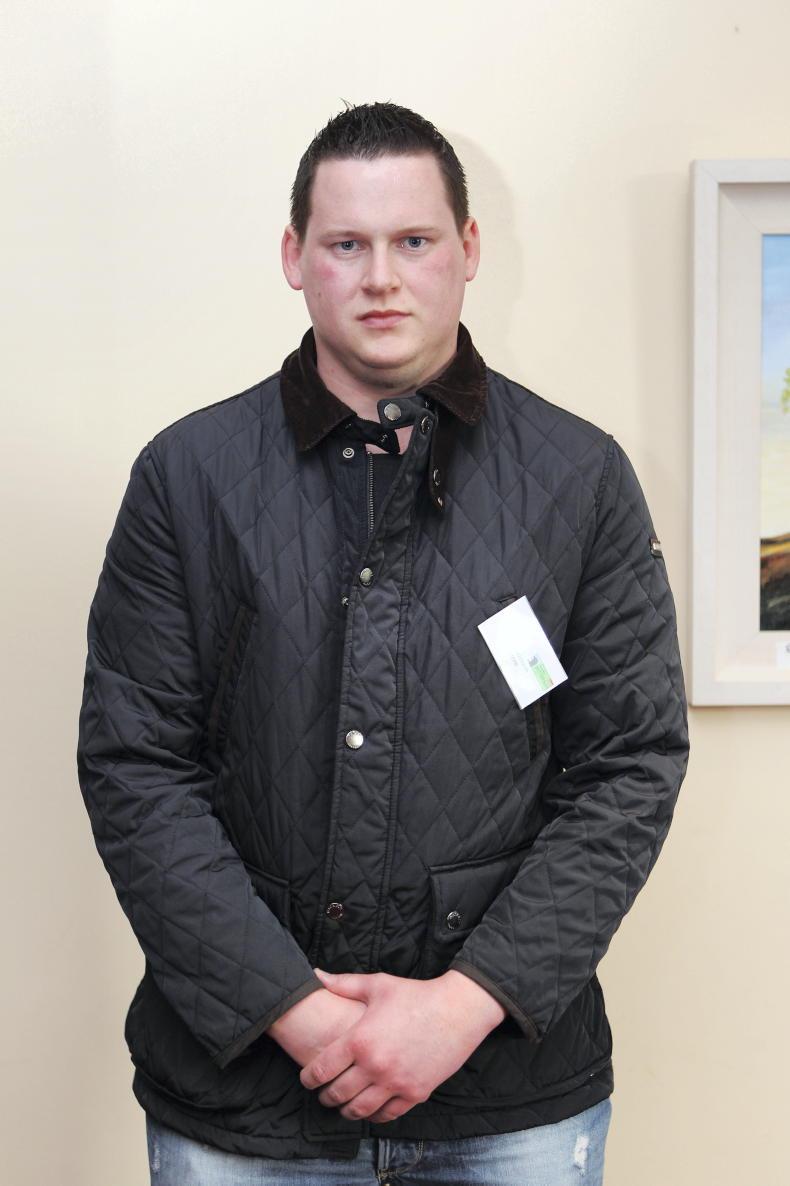
Niall Patterson.
Niall is currently using a lot of artificial insemination on the farm to breed stock and would like to move to 100% AI, but has been restricted from doing so previously due to the term of the Beef Data and Genomics Programme (BDGP), which required the farm to have a stock bull.
The suckler herd is currently running at a Euro-Star value of €115, which is within the top 10% in the country.
The main objective of the farm is output/livestock unit. The herd currently has a calving interval of 366 days – 27 days below the national average – with 0.96 calves/cow each year.
Niall’s aim is to breed as efficient an animal as possible, which will hopefully return profit to the overall farm system.
The financial figures speak for themselves. In 2022, 11 bulls were sold at an average age at slaughter of 15.3 months, with a carcase weight of 428kg. They grossed €2,149/head.
One of the standout animals in the bunch was a Limousin-cross cow, which bred a CH6367 bull calf (born in September), and was killed at 14 months at over 800kg live and 496kg dead.
Niall had four September-born bull calves on display, which will remain housed. They are currently being fed 2kg-3kg of meal, which will be built up to ad lib for 90 days before finishing in December at under 16 months.
These animals are gaining 1.7-1.8kg/day on just 2kg-3kg of meal while still on their mothers. He stated that animals sired by Docile (CH6367) thrive really well when moved on to ad lib meal.
Breeding
In 2022, Niall averaged a price of €1,650 for every animal sold from the farm, from weanling heifers to cull cows. Niall breeds all his own replacements, with all bulls and surplus heifer calves sold as weanlings.
He made it clear to farmers that if you are looking to breed replacements, you should focus on the replacement stars; while if you are looking to breed finishing cattle, you focus on the terminal stars.
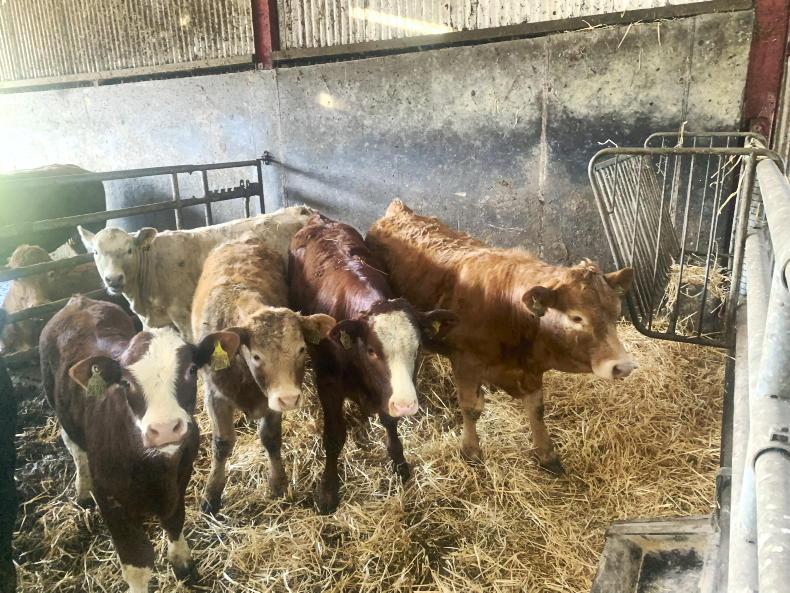
A selection of calves that remained housed and are sucking cows on the Patterson farm.
The heifers are used to breed replacements, as they allow Niall to make the most genetic gain within the herd. He believes that a mature cow who will have more milk should be utilised to breed an animal intended for finishing.
Maiden heifers showing more muscle are bred using an Aberdeen Angus bull for ease of calving.
Niall stressed the importance of efficiency to those in attendance in order to operate a profitable enterprise, and it begins with choosing suitable bulls with 4/5 stars and good carcase figures, as you want an efficient animal that will kill out at least 400kg.

Cows that are still housed due to the current ground conditions on the Patterson farm.
It’s important to maximize feed conversion, so that young stock can maintain weight gain with reduced levels of feed.
He also reassured farmers not be afraid of using AI test bulls from Gene Ireland, as 10 out of 14 calves in the shed were sired by test bulls.
SCEP
One of the main topics discussed at the meeting was the new Suckler Carbon Efficiency Programme.
The large crowd that attended the walk had a lot of questions around the new programme and how farmers would hit the new targets. Niall was a participant in BDGP and has already joined SCEP.
He said: “We would be hitting the targets for most of the items already, so it’s a no-brainer for us to join the SCEP. You just can’t afford not to in my opinion.”
There were a lot of questions around the requirement to be Bord Bia Quality Assured as part of the scheme. Rebecca O’Halleran, dairy farmer, outlined the application procedure and common mistakes farmers make while in the scheme.
An issue for farmers with rare breeds of animals came up with a farmer in attendance with Dexter cattle, who said it is more difficult for him to enter the scheme due to his cattle not being 4/5 stars across all breeds.
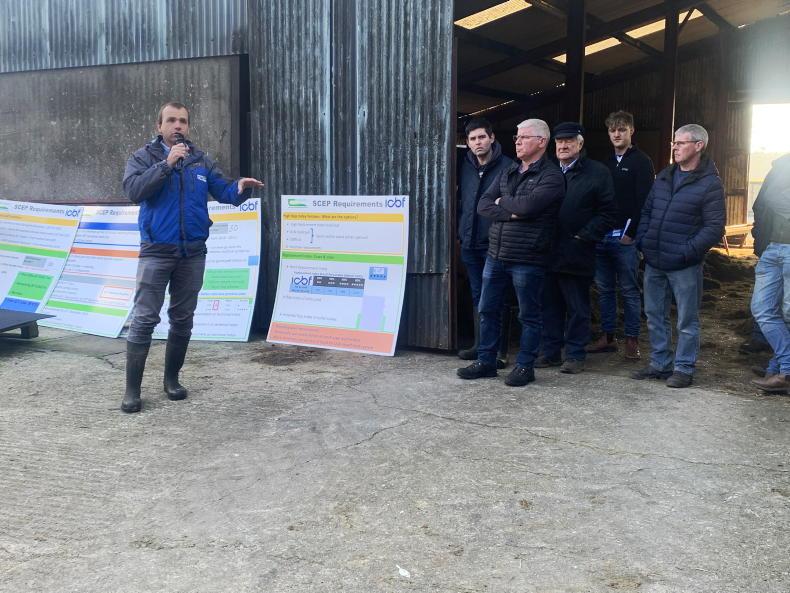
Niall Kilrane from ICBF answering queries from farmers about the Euro-Star index of cattle within their herds.
Niall Kilrane from ICBF stated that at present it is harder for those less populated breeds to compete with commercial breeds, but that the Department of Agriculture are willing to look at these rare breed participants on a case-by-case basis.
The important thing is to apply to the scheme and try to sort out the issues later, he said.
As with in many parts of the northwest, very few cattle have been turned out to grass due to the current ground conditions.
This has been no different for the Patterson family, explained Niall.
“All of our cattle are still housed due to ground conditions. That’s just down to the heavy nature of the soils on which we farm, but we have been fortunate to have enough fodder to carry us through the extended winter season so far.
“We currently have ewes and lambs out grazing the paddocks.
“Twelve acres of the farm has received silage fertiliser. We got slurry out during February’s dry spell on grazing ground to keep the tanks under control.
“Cows and calves are ready to head to grass, so we hope to get a dry spell to let ground recover and get them out to relieve the workload around the yard.”
Teagasc has been running a series of breeding events on farms around the country in association with the Irish Cattle Breeding Federation (ICBF) over the last few weeks.
Last week was the turn of Leitrim, with Carrigallen man Niall Patterson as the host for the evening. Niall is no stranger to the Irish Farmers Journal, having been a participant on the Teagasc/Irish Farmers Journal BETTER Farm Beef programme a few years back.
Tom Coll, James Keane and Catherine Egan, Teagasc all spoke on the night along with Niall Kilrane from ICBF.
The Patterson family run a commercial herd of 35 spring/autumn calving cows, predominantly Charolais and Limousin-crossed, along with 100 lambing ewes on their 40ha farm.

Niall Patterson.
Niall is currently using a lot of artificial insemination on the farm to breed stock and would like to move to 100% AI, but has been restricted from doing so previously due to the term of the Beef Data and Genomics Programme (BDGP), which required the farm to have a stock bull.
The suckler herd is currently running at a Euro-Star value of €115, which is within the top 10% in the country.
The main objective of the farm is output/livestock unit. The herd currently has a calving interval of 366 days – 27 days below the national average – with 0.96 calves/cow each year.
Niall’s aim is to breed as efficient an animal as possible, which will hopefully return profit to the overall farm system.
The financial figures speak for themselves. In 2022, 11 bulls were sold at an average age at slaughter of 15.3 months, with a carcase weight of 428kg. They grossed €2,149/head.
One of the standout animals in the bunch was a Limousin-cross cow, which bred a CH6367 bull calf (born in September), and was killed at 14 months at over 800kg live and 496kg dead.
Niall had four September-born bull calves on display, which will remain housed. They are currently being fed 2kg-3kg of meal, which will be built up to ad lib for 90 days before finishing in December at under 16 months.
These animals are gaining 1.7-1.8kg/day on just 2kg-3kg of meal while still on their mothers. He stated that animals sired by Docile (CH6367) thrive really well when moved on to ad lib meal.
Breeding
In 2022, Niall averaged a price of €1,650 for every animal sold from the farm, from weanling heifers to cull cows. Niall breeds all his own replacements, with all bulls and surplus heifer calves sold as weanlings.
He made it clear to farmers that if you are looking to breed replacements, you should focus on the replacement stars; while if you are looking to breed finishing cattle, you focus on the terminal stars.

A selection of calves that remained housed and are sucking cows on the Patterson farm.
The heifers are used to breed replacements, as they allow Niall to make the most genetic gain within the herd. He believes that a mature cow who will have more milk should be utilised to breed an animal intended for finishing.
Maiden heifers showing more muscle are bred using an Aberdeen Angus bull for ease of calving.
Niall stressed the importance of efficiency to those in attendance in order to operate a profitable enterprise, and it begins with choosing suitable bulls with 4/5 stars and good carcase figures, as you want an efficient animal that will kill out at least 400kg.

Cows that are still housed due to the current ground conditions on the Patterson farm.
It’s important to maximize feed conversion, so that young stock can maintain weight gain with reduced levels of feed.
He also reassured farmers not be afraid of using AI test bulls from Gene Ireland, as 10 out of 14 calves in the shed were sired by test bulls.
SCEP
One of the main topics discussed at the meeting was the new Suckler Carbon Efficiency Programme.
The large crowd that attended the walk had a lot of questions around the new programme and how farmers would hit the new targets. Niall was a participant in BDGP and has already joined SCEP.
He said: “We would be hitting the targets for most of the items already, so it’s a no-brainer for us to join the SCEP. You just can’t afford not to in my opinion.”
There were a lot of questions around the requirement to be Bord Bia Quality Assured as part of the scheme. Rebecca O’Halleran, dairy farmer, outlined the application procedure and common mistakes farmers make while in the scheme.
An issue for farmers with rare breeds of animals came up with a farmer in attendance with Dexter cattle, who said it is more difficult for him to enter the scheme due to his cattle not being 4/5 stars across all breeds.

Niall Kilrane from ICBF answering queries from farmers about the Euro-Star index of cattle within their herds.
Niall Kilrane from ICBF stated that at present it is harder for those less populated breeds to compete with commercial breeds, but that the Department of Agriculture are willing to look at these rare breed participants on a case-by-case basis.
The important thing is to apply to the scheme and try to sort out the issues later, he said.
As with in many parts of the northwest, very few cattle have been turned out to grass due to the current ground conditions.
This has been no different for the Patterson family, explained Niall.
“All of our cattle are still housed due to ground conditions. That’s just down to the heavy nature of the soils on which we farm, but we have been fortunate to have enough fodder to carry us through the extended winter season so far.
“We currently have ewes and lambs out grazing the paddocks.
“Twelve acres of the farm has received silage fertiliser. We got slurry out during February’s dry spell on grazing ground to keep the tanks under control.
“Cows and calves are ready to head to grass, so we hope to get a dry spell to let ground recover and get them out to relieve the workload around the yard.”











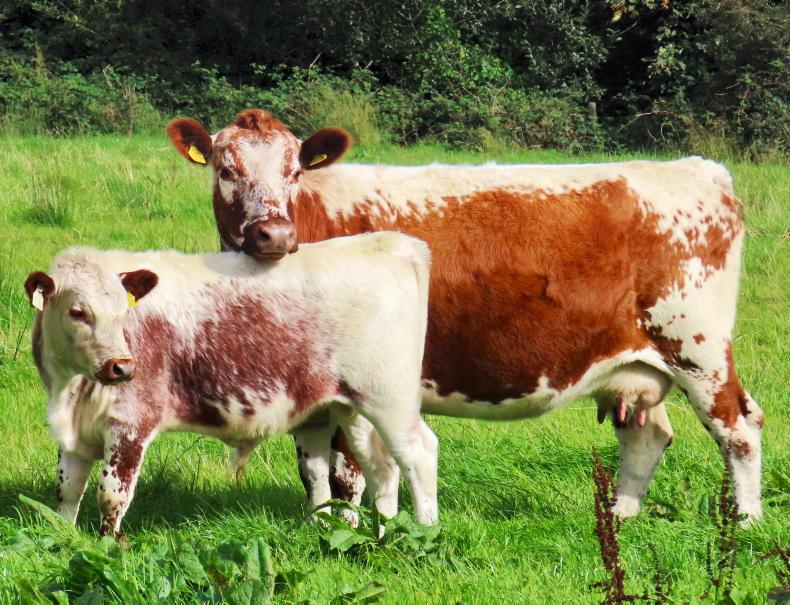
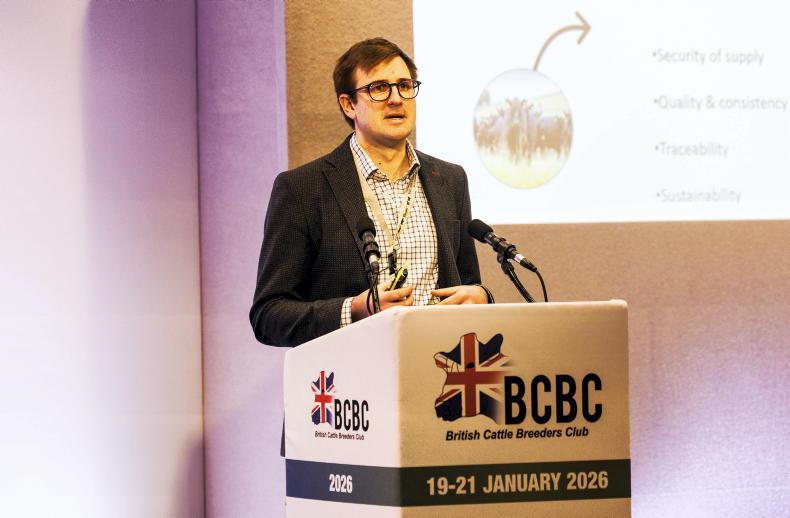
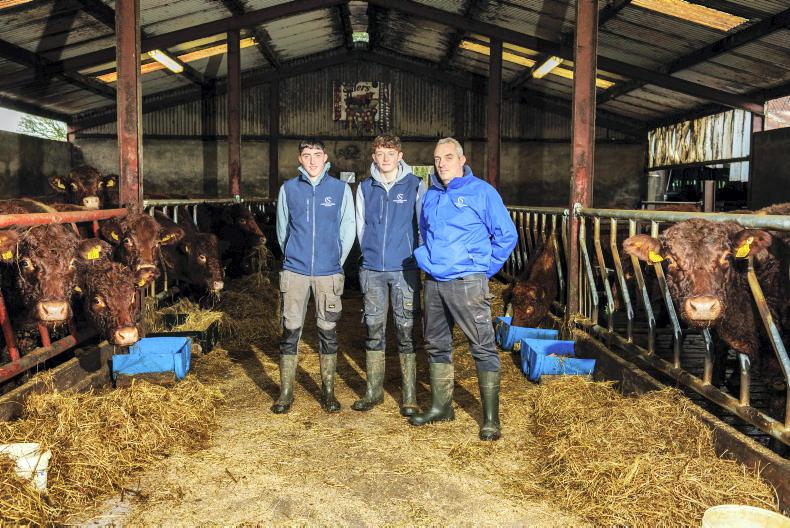
SHARING OPTIONS